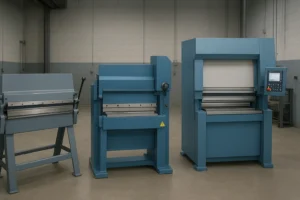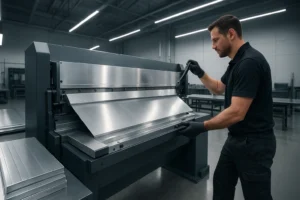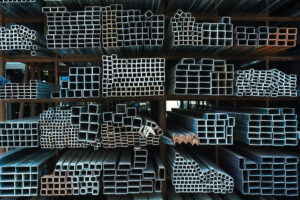Stainless steel is one of the most popular materials in kitchens, restaurants, and industries worldwide. From cutlery and cookware to appliances and medical equipment, it’s valued for its durability, corrosion resistance, and sleek finish. But if you’ve ever shopped for stainless steel products, you’ve probably noticed labels like 18/8, 18/10, or 18/0.
So, what do these numbers mean? And how do you decide which stainless steel grade is right for you?
In this blog, we’ll break down the differences between 18/8, 18/10, and 18/0 stainless steels, their pros and cons, and their best uses so you can make the right choice whether for your kitchen, restaurant, or manufacturing needs.
Understanding Stainless Steel Numbers
The numbers like 18/8 or 18/10 refer to the percentage of chromium and nickel in the stainless steel alloy.
- The first number (18) always refers to chromium content. Chromium gives stainless steel its resistance to rust and corrosion.
- The second number (8, 10, or 0) refers to nickel content. Nickel enhances strength, shine, and corrosion resistance.
This system is commonly used to classify austenitic stainless steels in the 300 series, as well as ferritic stainless steels like 18/0.
What is 18/8 Stainless Steel ?
Composition:
- 18% chromium
- 8% nickel
18/8 stainless steel is one of the most widely used alloys in the world. It’s strong, durable, and resistant to rust, making it a favorite in both household and industrial applications.
Key Features:
- Excellent corrosion resistance
- Durable and long-lasting
- Shiny, polished appearance
- Affordable compared to higher-nickel steels
Best Uses:
- Kitchen utensils
- Cookware and mixing bowls
- Food processing equipment
- Outdoor furniture
18/8 stainless steel is often referred to as “304 stainless steel”, making it the industry standard for many kitchen and food service products.
18/8 vs 18/10 stainless steel: Key Differences Explained
When comparing 18/8 vs 18/10 stainless steel, the primary difference lies in their nickel content. 18/8 stainless steel contains 18% chromium and 8% nickel, offering good durability, corrosion resistance, and a shiny finish. It’s commonly used in flatware, kitchen utensils, and appliances, providing reliable performance in most household settings.
18/10 stainless steel has 18% chromium and 10% nickel, making it slightly more resistant to rust and corrosion. The higher nickel content also gives it a more polished, long-lasting shine. This makes it an ideal choice for premium kitchenware, cookware, and high-end appliances that need to withstand more demanding conditions over time.
What is18/10 Stainless Steel ?
Composition:
- 18% chromium
- 10% nickel
18/10 stainless steel is very similar to 18/8 but contains slightly more nickel. That small difference in composition makes a noticeable difference in shine, durability, and resistance to corrosion.
Key Features:
- Superior corrosion resistance
- More lustrous, mirror-like shine
- Stronger and more durable than 18/8
- Holds polish for longer
Best Uses:
- High-end cutlery
- Premium cookware
- Professional kitchen equipment
- Decorative items and serving ware
Because of its durability and attractive appearance, 18/10 stainless steel is often found in fine dining cutlery and premium kitchenware. It’s also common in medical tools and industrial equipment where resistance to rust is critical.
What is 18/0 Stainless Steel ?
Composition:
- 18% chromium
- 0% nickel
18/0 stainless steel belongs to the ferritic family of stainless steels. Unlike 18/8 and 18/10, it contains no nickel, which makes it more affordable but also less resistant to corrosion.
Key Features:
- Chromium-based corrosion resistance (lower than 18/8 or 18/10)
- Harder but more brittle compared to nickel-containing steels
- More prone to staining or rust in humid environments
- More affordable due to lack of nickel
Best Uses:
- Budget-friendly cutlery
- Flatware in large-scale catering
- Decorative items not exposed to water for long periods
- Appliances with short-term or occasional use
While 18/0 stainless steel is not as durable as the nickel-containing grades, it’s a cost-effective option when budget is a priority.
Key Differences Between 18/8, 18/10, and 18/0 Stainless Steel
| Feature | 18/8 Stainless Steel | 18/10 Stainless Steel | 18/0 Stainless Steel |
|---|---|---|---|
| Chromium Content | 18% | 18% | 18% |
| Nickel Content | 8% | 10% | 0% |
| Corrosion Resistance | Very Good | Excellent | Moderate |
| Shine & Appearance | Polished | More Lustrous | Duller |
| Durability | Strong | Strongest | Less Durable |
| Price Range | Moderate | Higher | Lowest |
| Best For | Everyday use | Premium use | Budget-friendly use |
Pros and Cons of Each Type
18/8 Stainless Steel
✅ Affordable and durable
✅ Good corrosion resistance
❌ Slightly less shine than 18/10
18/10 Stainless Steel
✅ Highest resistance to corrosion
✅ Most polished and long-lasting
❌ More expensive than 18/8 and 18/0
18/0 Stainless Steel
✅ Cost-effective and nickel-free (good for nickel allergies)
✅ Harder surface
❌ Less resistant to rust
❌ Shorter lifespan in damp environments
Which Stainless Steel Should You Choose?
- Choose 18/8 if you need a balance between cost and durability. Great for everyday cookware, utensils, and food service equipment.
- Choose 18/10 if you want the best quality, shine, and corrosion resistance. Ideal for professional kitchens, fine dining, and premium home cookware.
- Choose 18/0 if you’re looking for a budget-friendly option for cutlery or appliances that won’t be exposed to water continuously.
FAQs About 18/8, 18/10, and 18/0 Stainless Steel
1. Is 18/10 stainless steel better than 18/8?
Yes. The higher nickel content makes 18/10 more resistant to corrosion and gives it a shinier, more polished look.
2. Does 18/0 stainless steel rust?
It can, especially in humid or damp environments, since it lacks nickel for added corrosion protection.
3. Are all three types safe for food use?
Yes, all are safe and commonly used in cutlery, cookware, and kitchen tools.
4. Why is 18/0 stainless steel cheaper?
Because it contains no nickel, which is an expensive alloying element.
5. Which type is best for restaurants?
Most restaurants prefer 18/10 stainless steel for its shine, strength, and resistance to heavy daily use.
Conclusion
Stainless steel is an essential material in kitchens, industries, and homes. While all three grades 18/8, 18/10, and 18/0 stainless steel have 18% chromium, their nickel content makes the real difference.
- 18/8 balances affordability and durability.
- 18/10 offers premium strength and corrosion resistance.
- 18/0 provides a budget option with decent performance.
By understanding these differences, you can confidently choose the right stainless steel for your needs whether you’re buying cutlery, cookware, or industrial equipment.
In short, the choice between 18/8, 18/10, and 18/0 stainless steel comes down to your budget, usage, and durability requirements.






